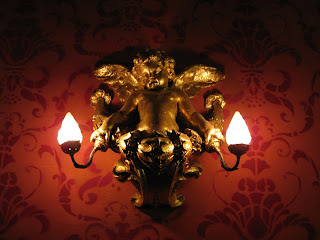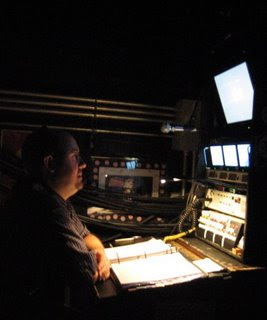The Colonial is an absolutely beautiful theatre. The backstage space is cramped and loading-in is a pain in the neck, but I've really enjoyed coming to work everyday here. It feels like coming to work at a Broadway theatre. The Colonial is also the Spamalot tour's birthplace. The tour teched, previewed and opened here two and half year's ago. The crew is top notch and this is third time many of them have worked the show (the original run at the colonial, two weeks at the Opera House in January and now our third coming).
The Colonial opened its doors in December of 1900. The theatre is actually part of a larger office building on Boylston Street facing Boston Common. The premier performance was Ben Hur and featured a cast of 350 and even 8 horses that simulated a chariot race at full gallop on stage. Since then, it's been one of the preferred out-of-town try-out houses for shows on their way to Broadway. In fact, it was at the Colonial that a musical entitled Away We Go! replaced the title number and was renamed Oklahoma! on its way to a Broadway bow in 1943. The theatre's marquee was badly damaged when a delivery truck crashed into the overhang (the marquee is now almost flush with the building), but otherwise the theatre appears much as it did when Anything Goes, Porgy and Bess and Follies previewed here.

The Colonial's front door & truncated marquee
The interior of the theatre is magnificent. Hidden behind the rather unassuming facade is a jewel box. The interior designs are by H.B. Pennell and were clearly created to dazzle theatre goers.

The lobby is designed to be reminiscent of the Hall of Mirrors at Versailles

The auditorium features gilt plaster work and giant marble columns

Gilt cherubs are everywhere

The ceiling features several murals - this one is just above the proscenium
The stage house is just large enough to contain Spamalot. We filled all the available space and had to be creative with the quick change areas (the girls on stage left are actually using a star dressing room complete with a large white sofa that the hands couldn't find a way to get out of the room!). The Colonial is also one of the few remaining hemp houses on the road. (Instead of a more modern system with permanent arbors to hold the counterweights for the flying pieces, a hemp house uses sandbags lashed on to the hemp ropes that support and operate the flying pieces.) The antiquated fly system is perfectly functional, but made our load-in even more challenging. The Colonial also doesn't have a traditional loading dock: 1 truck at a time can back up Allen's Alley to the loading door, everything on that truck has to be ramped down to the ground, pushed to a small elevator and then brought up to the stage. Just getting all the pieces into the Colonial took a long time.

Stage hands move road boxes to the loading door - the elevator is coming down to meet them at street level

One truck at a time could back down the alley to the stage door - the alley empties onto busy Tremont Street, necessitating a police man to direct traffic
The Colonial's support spaces, however, are charming. While there's not lots of room, the whole place is very homey feeling. There's lots of dark wood everywhere, even wainscoting on the walls. The building has obviously been well cared for.

I love the dressing rooms on the third floor - they're only big enough for one or two people, but they feel so inviting

The Stage Managers' office is in the former Smoking Lounge

The building is full of old fashioned, hand-painted signage - I love this stuff

Of course, there are a few things about the Colonial that I'd like to see changed....
The Colonial has been a great place to come to work all week. After all the work the crew did cramming us into this beautiful theatre, it's truly a shame that we're only staying for a week.
JV


No comments:
Post a Comment